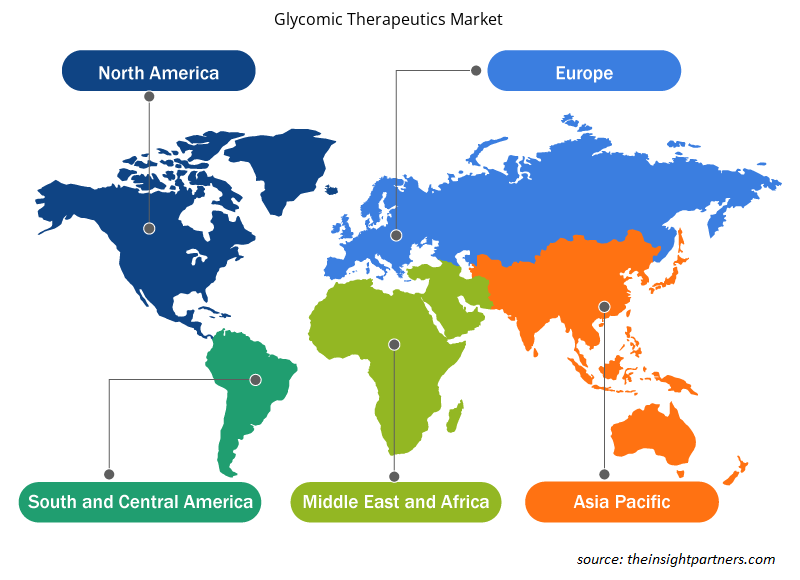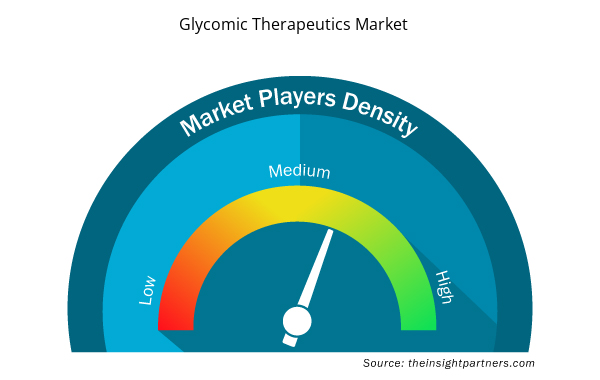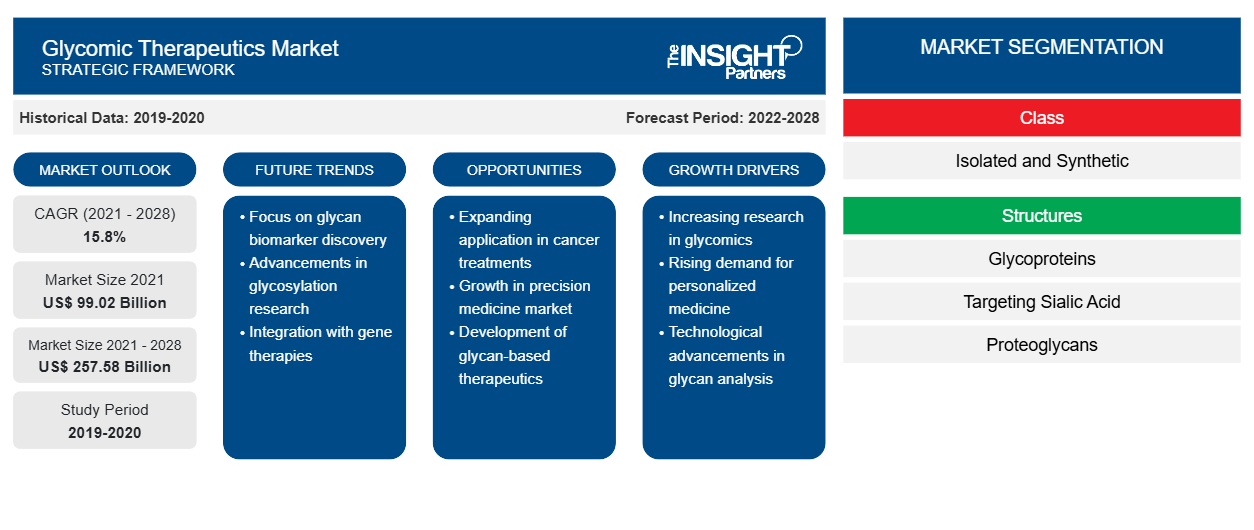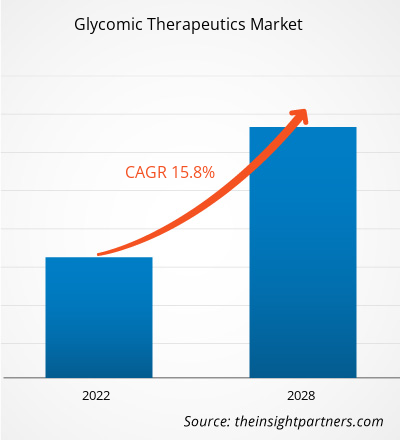Der Markt für Glykomtherapeutika soll von 99.021,46 Millionen US-Dollar im Jahr 2021 auf 257.578,79 Millionen US-Dollar im Jahr 2028 wachsen; von 2022 bis 2028 wird mit einer durchschnittlichen jährlichen Wachstumsrate von 15,8 % gerechnet .glycomic therapeutics market is expected to grow from US$ 99,021.46 million in CAGR of 15.8% from 2022
Der Bericht hebt die vorherrschenden Trends und Faktoren hervor, die das Marktwachstum vorantreiben. Die Glykomik konzentriert sich auf die Strukturen und Funktionen komplexer Kohlenhydrate, wie sie in Glykoproteinen, Glykolipiden und Glykosaminoglykanen vorkommen. Glykane sind für einen Großteil der strukturellen Variation in biologischen Systemen verantwortlich, und ihre Darstellung auf Zelloberflächen wird allgemein als „Glykom“ bezeichnet. Diese Glykane sind in vielen Bereichen des Mikrobioms vorhanden, einschließlich Zelloberflächen und Proteinen, und können unglaublich komplex sein. Die mikrobielle Glykomik wird die Krankheitsdiagnose, die Krebserkennung, die personalisierte Medizin, antimikrobielle Impfstoffe und die Arzneimittelentdeckung revolutionieren. Als Therapeutika können glykanintegrierte Nanomaterialien als Impfstoff gegen virale und bakterielle Infektionen und Krebszellen eingesetzt werden.
Der Bericht bietet Einblicke und eine eingehende Analyse des globalen Marktes für Glykomtherapeutika und hebt dabei verschiedene Parameter hervor, darunter Markttrends, technologische Fortschritte, Marktdynamik und eine Wettbewerbslandschaftsanalyse der weltweit führenden Marktteilnehmer. Er umfasst auch die Auswirkungen der COVID-19-Pandemie auf den Markt in allen Regionen. Die Gesamtauswirkungen der COVID-19-Pandemie auf den Markt für Glykomtherapeutika waren gemischt; daher gewinnt der Markt immer noch an Dynamik und wird in den kommenden Jahren voraussichtlich wachsen. Die Gesundheitssysteme waren überlastet und die Bereitstellung medizinischer Versorgung für alle Patienten wurde zu einer Herausforderung. Darüber hinaus war die Biotechnologiebranche mit den unerwünschten Auswirkungen der Pandemie konfrontiert. Während der COVID-19-Pandemie hatten Hersteller medizinischer Geräte Schwierigkeiten, ihren Betrieb zu verwalten. Viele Unternehmen für Glykomtherapeutika hatten ihre Geschäftstätigkeit in den USA, und die Pandemie hat mehrere Unternehmen schwer getroffen. Nachdem sich die Pandemiebeschränkungen jedoch normalisiert hatten, kehrte das Volumen der chirurgischen Eingriffe auf ein normales Niveau zurück. Allmählich nahmen die Krankenhäuser die planmäßigen Eingriffe wieder auf, da die Genesungsrate von COVID-19 zunahm. Auch die Nachfrage nach Glykan-basierten Arzneimitteln in der medizinischen Therapie und Impfstoffentwicklung ist gestiegen.
Passen Sie diesen Bericht Ihren Anforderungen an
Sie erhalten kostenlose Anpassungen an jedem Bericht, einschließlich Teilen dieses Berichts oder einer Analyse auf Länderebene, eines Excel-Datenpakets sowie tolle Angebote und Rabatte für Start-ups und Universitäten.
- Holen Sie sich die wichtigsten Markttrends aus diesem Bericht.Dieses KOSTENLOSE Beispiel umfasst eine Datenanalyse von Markttrends bis hin zu Schätzungen und Prognosen.
Geographiebasierte Erkenntnisse
Geografisch ist der globale Markt für Glykomtherapeutika in Nordamerika (USA, Kanada und Mexiko), Europa (Großbritannien, Deutschland, Frankreich, Italien, Spanien und das übrige Europa), den asiatisch-pazifischen Raum (China, Japan, Indien, Australien, Südkorea und den übrigen asiatisch-pazifischen Raum), den Nahen Osten und Afrika (die Vereinigten Arabischen Emirate, Saudi-Arabien, Südafrika und den übrigen Nahen Osten und Afrika) sowie Süd- und Mittelamerika (Brasilien, Argentinien und den übrigen Süd- und Mittelamerika) unterteilt.
Markteinblicke
Zunehmende Forschung und Entwicklung im Bereich der Glykomtherapie
Glykane sind äußerst komplex und kommen in vielen Bereichen der Mikrobiomkomponenten vor, beispielsweise in Proteinen und Zelloberflächen. Forscher und Akteure sind aktiv in der Glykomikbranche tätig und konzentrieren sich ständig auf technologische Entwicklungen, um bessere Alternativen zu herkömmlichen Techniken anzubieten. Im Folgenden sind einige Beispiele für Forschung und Entwicklung auf dem Markt für Glykomiktherapeutika aufgeführt:
- Im Februar 2022 vergab die National Science Foundation (NSF) rund 23 Millionen US-Dollar an eine neue Partnerschaft mehrerer Universitäten, die gemeinsam von Virginia Tech und der University of Georgia geleitet wird, um die Glykomaterialforschung in den USA voranzutreiben. Diese Partnerschaft brachte Spitzenwissenschaftler und Ingenieure dieser Institutionen sowie der Brandeis University, des Rensselaer Polytechnic Institute und der University of North Carolina in Chapel Hill zusammen, um ein nationales Forschungszentrum für Glykomaterialien zu gründen.
- Im März 2022 gab Palleon Pharmaceuticals, ein Pionierunternehmen auf dem Gebiet der Glykol-Immunologie zur Behandlung von Krebs und entzündlichen Erkrankungen, die Dosierung des ersten Patienten in der Phase-1/2-Studie des Unternehmens zu E-602 bei Patienten mit fortgeschrittenem Krebs bekannt. Die Studie mit dem Namen GLIMMER-01 (Glycan-Immune Regulation) ist die erste klinische Studie zu Palleons neuartigem Ansatz zur Krebsimmuntherapie, der auf immunsuppressive Sialoglycane abzielt.
- Im April 2022 entwickelten die Glykoproteomik-Forscher des CPTAC eine „Peptide-First“-Methode zur multiattributiven Glykanidentifizierung.
- Im März 2022 deckten japanische Forscher den genauen Mechanismus eines Beta-1,2-Glucan-assoziierten Enzyms auf und lieferten damit neue Erkenntnisse zum komplexen Zuckerstoffwechsel. Ein Forscherteam der Niigata University und der Tokyo University of Science identifizierte die Struktur und Funktion eines neuen Enzyms mit Glycosyltransferase-Aktivität. Die Ergebnisse dieser Untersuchung wurden am 19. Januar 2022 veröffentlicht und im Journal of Biological Chemistry, Band 298, Ausgabe 3, abgedruckt.
- Laut einer im Februar 2022 veröffentlichten Studie von Forschern des Zentrums für Glykomik der Universität Kopenhagen kann Heparin durch Glykomikstudien nun ohne den Einsatz von Tieren hergestellt werden.
- Im Februar 2022 feierte GlycoMIP, ein nationales Forschungszentrum mit Schwerpunkt auf Glykomaterialforschung, das gemeinsam von Virginia Tech und der University of Georgia geleitet wird, die feierliche Eröffnung seiner nationalen Benutzereinrichtung mit feierlichen Eröffnungszeremonien an beiden Universitäten. GlycoMIP wird landesweite Engpässe bei der Glykomaterialsynthese, der Computermodellierung, der Materialcharakterisierung und dem Wissensaustausch durch bahnbrechende Forschung und eine einzigartige nationale Benutzereinrichtung beheben, die der wissenschaftlichen Gemeinschaft wichtige Werkzeuge und Dienste zur Verfügung stellen wird.
Solche Fortschritte auf dem Gebiet der Glykomik treiben das Wachstum des Marktes für Glykomik-Therapeutika erheblich voran.
Klassenbasierte Einblicke
Basierend auf der Klasse ist der Markt für Glykomtherapeutika in isolierte und synthetische unterteilt. Im Jahr 2021 hatte das synthetische Segment einen größeren Marktanteil. Es wird jedoch erwartet, dass das isolierte Segment im Prognosezeitraum eine höhere durchschnittliche jährliche Wachstumsrate (CAGR) von 16,3 % verzeichnet.
Strukturbasierte Erkenntnisse
Basierend auf Strukturen ist der Markt für Glykomtherapeutika segmentiert in Glykoproteine, die auf Sialinsäure abzielen, Proteoglykane, die auf Glykosaminoglykane abzielen, Glykophosphatidylinositol (GPI)-verankerte Proteine und Heparin-basierte Glykane, die auf Glykosphingolipide abzielen und andere. Das Segment Glykoproteine hatte 2021 den größten Marktanteil. Es wird jedoch erwartet, dass das Segment der auf Sialinsäure abzielenden Glykotherapeutika im Prognosezeitraum die höchste durchschnittliche jährliche Wachstumsrate verzeichnet.
Indikationsbasierte Erkenntnisse
Basierend auf der Indikation ist der Markt für Glykom-Therapeutika segmentiert in Thrombose und Chemoprophylaxe, Anämie, Antiadhäsiv- und Entzündungshemmer, Katarakt, Morbus Gaucher , MPS-1 und IV, Krebs, Alzheimer-Krankheit, Influenza Typ A und B und andere. Das Segment Influenza Typ A und B hatte 2021 den größten Marktanteil und es wird erwartet, dass sich im Prognosezeitraum ein ähnlicher Trend fortsetzt.
Regionale Einblicke in den Markt für Glykomtherapeutika
Die regionalen Trends und Faktoren, die den Markt für Glykom-Therapeutika im Prognosezeitraum beeinflussen, wurden von den Analysten von Insight Partners ausführlich erläutert. In diesem Abschnitt werden auch die Marktsegmente und die Geografie von Glykom-Therapeutika in Nordamerika, Europa, im asiatisch-pazifischen Raum, im Nahen Osten und Afrika sowie in Süd- und Mittelamerika erörtert.

- Erhalten Sie regionale Daten zum Markt für Glykomtherapeutika
Umfang des Marktberichts zu Glykomtherapeutika
| Berichtsattribut | Details |
|---|---|
| Marktgröße im Jahr 2021 | 99,02 Milliarden US-Dollar |
| Marktgröße bis 2028 | 257,58 Milliarden US-Dollar |
| Globale CAGR (2021 - 2028) | 15,8 % |
| Historische Daten | 2019-2020 |
| Prognosezeitraum | 2022–2028 |
| Abgedeckte Segmente | Nach Klasse
|
| Abgedeckte Regionen und Länder | Nordamerika
|
| Marktführer und wichtige Unternehmensprofile |
|
Marktteilnehmerdichte für Glykomtherapeutika: Auswirkungen auf die Geschäftsdynamik verstehen
Der Markt für Glykomtherapeutika wächst rasant, angetrieben durch die steigende Nachfrage der Endverbraucher aufgrund von Faktoren wie sich entwickelnden Verbraucherpräferenzen, technologischen Fortschritten und einem größeren Bewusstsein für die Vorteile des Produkts. Mit steigender Nachfrage erweitern Unternehmen ihr Angebot, entwickeln Innovationen, um die Bedürfnisse der Verbraucher zu erfüllen, und nutzen neue Trends, was das Marktwachstum weiter ankurbelt.
Die Marktteilnehmerdichte bezieht sich auf die Verteilung der Firmen oder Unternehmen, die in einem bestimmten Markt oder einer bestimmten Branche tätig sind. Sie gibt an, wie viele Wettbewerber (Marktteilnehmer) in einem bestimmten Marktraum im Verhältnis zu seiner Größe oder seinem gesamten Marktwert präsent sind.
Die wichtigsten auf dem Markt für Glykomtherapeutika tätigen Unternehmen sind:
- Intellihep GmbH
- Protalix Biotherapeutika
- BioMarin Pharmaceutical Inc.
- Genzyme Corporation (Sanofi)
- Halozyme Therapeutics, Inc.
Haftungsausschluss : Die oben aufgeführten Unternehmen sind nicht in einer bestimmten Reihenfolge aufgeführt.

- Überblick über die wichtigsten Akteure auf dem Markt für Glykomtherapeutika
Wirkungsweisebasierte Erkenntnisse
Basierend auf der Wirkungsweise ist der Markt für Glykomtherapeutika segmentiert in Hemmer der Neuraminidase; Hemmer der Heparanase und Selektine und Blockierung der Wechselwirkungen zwischen Wachstumsfaktoren und Heparansulfat; Erythropoietin und Enzymersatztherapie (ERT) ; Gewebeplasminogenaktivator; Hemmer der Glucosylceramidsynthase; Interleukin 1, 2 und 3; Beta- und Gamma-Interferone; und andere. Im Jahr 2021 hielt das Segment Erythropoietin und Enzymersatztherapie (ERT) den größten Marktanteil. Es wird jedoch erwartet, dass das Segment Hemmer der Neuraminidase im Prognosezeitraum die höchste durchschnittliche jährliche Wachstumsrate verzeichnet.
Intellihep Ltd; Protalix Biotherapeutics; BioMarin Pharmaceutical Inc.; Genzyme Corporation (Sanofi); Halozyme Therapeutics, Inc.; Bayer AG; Alzheon, Inc.; GlycoMar; GlaxoSmithKline plc.; und F. Hoffmann-La Roche Ltd gehören zu den führenden Akteuren auf dem Markt für Glykomtherapeutika. Diese Unternehmen haben verschiedene Strategien umgesetzt, die ihr Wachstum gefördert haben, was zu mehreren Entwicklungen auf dem Markt geführt hat.
- Historische Analyse (2 Jahre), Basisjahr, Prognose (7 Jahre) mit CAGR
- PEST- und SWOT-Analyse
- Marktgröße Wert/Volumen – Global, Regional, Land
- Branche und Wettbewerbsumfeld
- Excel-Datensatz


- Pipe Relining Market
- Surety Market
- Artificial Intelligence in Healthcare Diagnosis Market
- Skin Graft Market
- Clinical Trial Supplies Market
- Quantitative Structure-Activity Relationship (QSAR) Market
- Europe Industrial Chillers Market
- Medical and Research Grade Collagen Market
- Arterial Blood Gas Kits Market
- Aquaculture Market

Report Coverage
Revenue forecast, Company Analysis, Industry landscape, Growth factors, and Trends

Segment Covered
This text is related
to segments covered.

Regional Scope
North America, Europe, Asia Pacific, Middle East & Africa, South & Central America

Country Scope
This text is related
to country scope.
Häufig gestellte Fragen
The growth of the market is attributed to wide application in various disorders followed by the development of new treatment processes, increasing research and development in the field of glycomic therapeutics, and expanding R&D investments and rising use of glycomics in various diseases leading to development of new treatment processes.
Based on geography, the APAC region is anticipated to witness the highest CAGR in glycomic therapeutics market during the forecast period.
The synthetic segment under class segment held the largest market share in 2021.
The glycomic therapeutics market majorly consists of the players such as Intellihep Ltd; Protalix Biotherapeutics; BioMarin Pharmaceutical Inc.; Genzyme Corporation (Sanofi); Halozyme Therapeutics, Inc.; Bayer AG; Alzheon, Inc.; GlycoMar; GlaxoSmithKline plc.; and F. Hoffmann-La Roche Ltd.
Trends and growth analysis reports related to Life Sciences : READ MORE..
The List of Companies - Glycomic Therapeutics Market
- Intellihep Ltd
- Protalix Biotherapeutics
- BioMarin Pharmaceutical Inc.
- Genzyme Corporation (Sanofi)
- Halozyme Therapeutics, Inc.
- Bayer AG
- Alzheon, Inc.
- GlycoMar
- GlaxoSmithKline plc.
- F. Hoffmann-La Roche Ltd
The Insight Partners performs research in 4 major stages: Data Collection & Secondary Research, Primary Research, Data Analysis and Data Triangulation & Final Review.
- Data Collection and Secondary Research:
As a market research and consulting firm operating from a decade, we have published and advised several client across the globe. First step for any study will start with an assessment of currently available data and insights from existing reports. Further, historical and current market information is collected from Investor Presentations, Annual Reports, SEC Filings, etc., and other information related to company’s performance and market positioning are gathered from Paid Databases (Factiva, Hoovers, and Reuters) and various other publications available in public domain.
Several associations trade associates, technical forums, institutes, societies and organization are accessed to gain technical as well as market related insights through their publications such as research papers, blogs and press releases related to the studies are referred to get cues about the market. Further, white papers, journals, magazines, and other news articles published in last 3 years are scrutinized and analyzed to understand the current market trends.
- Primary Research:
The primarily interview analysis comprise of data obtained from industry participants interview and answers to survey questions gathered by in-house primary team.
For primary research, interviews are conducted with industry experts/CEOs/Marketing Managers/VPs/Subject Matter Experts from both demand and supply side to get a 360-degree view of the market. The primary team conducts several interviews based on the complexity of the markets to understand the various market trends and dynamics which makes research more credible and precise.
A typical research interview fulfils the following functions:
- Provides first-hand information on the market size, market trends, growth trends, competitive landscape, and outlook
- Validates and strengthens in-house secondary research findings
- Develops the analysis team’s expertise and market understanding
Primary research involves email interactions and telephone interviews for each market, category, segment, and sub-segment across geographies. The participants who typically take part in such a process include, but are not limited to:
- Industry participants: VPs, business development managers, market intelligence managers and national sales managers
- Outside experts: Valuation experts, research analysts and key opinion leaders specializing in the electronics and semiconductor industry.
Below is the breakup of our primary respondents by company, designation, and region:

Once we receive the confirmation from primary research sources or primary respondents, we finalize the base year market estimation and forecast the data as per the macroeconomic and microeconomic factors assessed during data collection.
- Data Analysis:
Once data is validated through both secondary as well as primary respondents, we finalize the market estimations by hypothesis formulation and factor analysis at regional and country level.
- Macro-Economic Factor Analysis:
We analyse macroeconomic indicators such the gross domestic product (GDP), increase in the demand for goods and services across industries, technological advancement, regional economic growth, governmental policies, the influence of COVID-19, PEST analysis, and other aspects. This analysis aids in setting benchmarks for various nations/regions and approximating market splits. Additionally, the general trend of the aforementioned components aid in determining the market's development possibilities.
- Country Level Data:
Various factors that are especially aligned to the country are taken into account to determine the market size for a certain area and country, including the presence of vendors, such as headquarters and offices, the country's GDP, demand patterns, and industry growth. To comprehend the market dynamics for the nation, a number of growth variables, inhibitors, application areas, and current market trends are researched. The aforementioned elements aid in determining the country's overall market's growth potential.
- Company Profile:
The “Table of Contents” is formulated by listing and analyzing more than 25 - 30 companies operating in the market ecosystem across geographies. However, we profile only 10 companies as a standard practice in our syndicate reports. These 10 companies comprise leading, emerging, and regional players. Nonetheless, our analysis is not restricted to the 10 listed companies, we also analyze other companies present in the market to develop a holistic view and understand the prevailing trends. The “Company Profiles” section in the report covers key facts, business description, products & services, financial information, SWOT analysis, and key developments. The financial information presented is extracted from the annual reports and official documents of the publicly listed companies. Upon collecting the information for the sections of respective companies, we verify them via various primary sources and then compile the data in respective company profiles. The company level information helps us in deriving the base number as well as in forecasting the market size.
- Developing Base Number:
Aggregation of sales statistics (2020-2022) and macro-economic factor, and other secondary and primary research insights are utilized to arrive at base number and related market shares for 2022. The data gaps are identified in this step and relevant market data is analyzed, collected from paid primary interviews or databases. On finalizing the base year market size, forecasts are developed on the basis of macro-economic, industry and market growth factors and company level analysis.
- Data Triangulation and Final Review:
The market findings and base year market size calculations are validated from supply as well as demand side. Demand side validations are based on macro-economic factor analysis and benchmarks for respective regions and countries. In case of supply side validations, revenues of major companies are estimated (in case not available) based on industry benchmark, approximate number of employees, product portfolio, and primary interviews revenues are gathered. Further revenue from target product/service segment is assessed to avoid overshooting of market statistics. In case of heavy deviations between supply and demand side values, all thes steps are repeated to achieve synchronization.
We follow an iterative model, wherein we share our research findings with Subject Matter Experts (SME’s) and Key Opinion Leaders (KOLs) until consensus view of the market is not formulated – this model negates any drastic deviation in the opinions of experts. Only validated and universally acceptable research findings are quoted in our reports.
We have important check points that we use to validate our research findings – which we call – data triangulation, where we validate the information, we generate from secondary sources with primary interviews and then we re-validate with our internal data bases and Subject matter experts. This comprehensive model enables us to deliver high quality, reliable data in shortest possible time.


 Holen Sie sich ein kostenloses Muster für diesen Bericht
Holen Sie sich ein kostenloses Muster für diesen Bericht